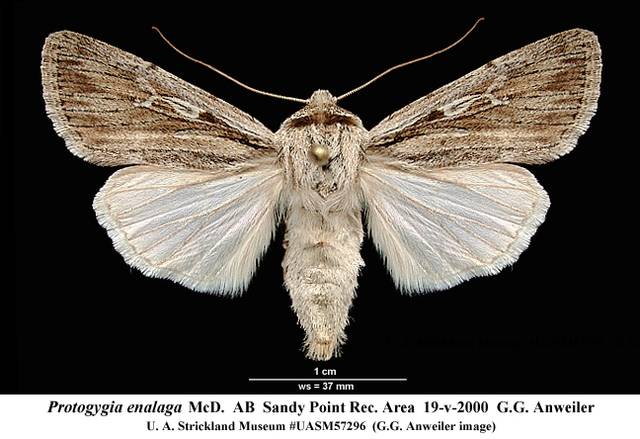« Back to your search
Species Details
Protogygia enalaga
University of Alberta E.H. Strickland Entomological Museum Read more about this collection »
SeasonalityAdults have been collected in Alberta in late May and early June.
IdentificationA medium-size (3.8-4.1 cm wingspan) streaky brownish-grey moth. The "normal" cross lines are obsolete, and the orbicular and reniform spots are elongated white-outlined doodles. The veins are lined with black scales and there are slightly darker streaks between the veins, darkest near the outer margin. A dusting of white scales along the costa and the lower edge of the wing gives them a frosted appearance. The most prominent marking is the rather thin black basal streak and the adjoining black scaling in the space basad to the orbicular. The hindwings are white, with a few dark scales along the veins in some specimens. The forewing fringes are lightly checkered, those of the hindwings solid white. Very similar to both P. postera Fauske & Laf. and Setagrotis radiola (Hamp.), both of which fly much later in the season, in August.
Scientific Name
Protogygia enalaga
Habitat
Arid native grassland-sagebrush valley floodplains and slopes; badlands
Seasonality
Adults have been collected in Alberta in late May and early June.
Identification
A medium-size (3.8-4.1 cm wingspan) streaky brownish-grey moth. The "normal" cross lines are obsolete, and the orbicular and reniform spots are elongated white-outlined doodles. The veins are lined with black scales…
A medium-size (3.8-4.1 cm wingspan) streaky brownish-grey moth. The "normal" cross lines are obsolete, and the orbicular and reniform spots are elongated white-outlined doodles. The veins are lined with black scales and there are slightly darker streaks between the veins, darkest near the outer margin. A dusting of white scales along the costa and the lower edge of the wing gives them a frosted appearance. The most prominent marking is the rather thin black basal streak and the adjoining black scaling in the space basad to the orbicular. The hindwings are white, with a few dark scales along the veins in some specimens. The forewing fringes are lightly checkered, those of the hindwings solid white. Very similar to both P. postera Fauske & Laf. and Setagrotis radiola (Hamp.), both of which fly much later in the season, in August.
Life History
Adults are nocturnal and come to light but have also been observed nectaring in numbers during the afternoon at wolf-willow (Eleagnus) blossoms (C. Schmidt and G. Anweiler, unpublished obs.). There is a single annual…
Adults are nocturnal and come to light but have also been observed nectaring in numbers during the afternoon at wolf-willow (Eleagnus) blossoms (C. Schmidt and G. Anweiler, unpublished obs.). There is a single annual brood, which emerges in the spring. The early stages are unknown.
Conservation
A rather common species in suitable habitat; no concerns
Range
Southern and coastal California north to southern Washington and southern Alberta, east to southwestern Saskatchewan, western Wyoming and Colorado.
References
Author
Lafontaine, J. Donald
Title
Noctuoidea : Noctuidae (part)
Publication Date
2004
Pages
385 pp.
Specimen Information
There are 64 specimens of this Species.
POHL-13-01036 - Protogygia enalaga
University of Alberta E.H. Strickland Entomological Museum
Place CollectedCanada: Alberta, Lost River
Collected ByPohl, G. R.
Date Collected1996-06-14
